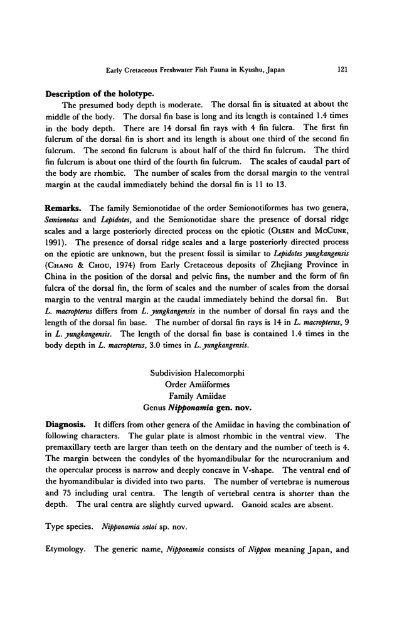Early Cretaceous Freshwater Fish Fauna in Kyushu, Japan
Early Cretaceous Freshwater Fish Fauna in Kyushu, Japan
Early Cretaceous Freshwater Fish Fauna in Kyushu, Japan
Create successful ePaper yourself
Turn your PDF publications into a flip-book with our unique Google optimized e-Paper software.
<strong>Early</strong> <strong>Cretaceous</strong> <strong>Freshwater</strong> <strong>Fish</strong> <strong>Fauna</strong> <strong>in</strong> <strong>Kyushu</strong>, <strong>Japan</strong> 121<br />
Description of the holotype.<br />
The presumed body depth is moderate. The dorsal f<strong>in</strong> is situated at about the<br />
middle of the body. The dorsal f<strong>in</strong> base is longand its length is conta<strong>in</strong>ed 1.4 times<br />
<strong>in</strong> the body depth. There are 14 dorsal f<strong>in</strong> rays with 4 f<strong>in</strong> fulcra. The first f<strong>in</strong><br />
fulcrum of the dorsal f<strong>in</strong> is short and its length is about one third of the second f<strong>in</strong><br />
fulcrum. The second f<strong>in</strong> fulcrum is about half of the third f<strong>in</strong> fulcrum. The third<br />
f<strong>in</strong> fulcrum is about one third of the fourth f<strong>in</strong> fulcrum. The scales of caudal part of<br />
the body are rhombic. The number of scales from the dorsal marg<strong>in</strong> to the ventral<br />
marg<strong>in</strong> at the caudal immediately beh<strong>in</strong>d the dorsal f<strong>in</strong> is 11 to 13.<br />
Remarks. The family Semionotidae of the order Semionotiformes has two genera,<br />
Semionotus and Lepidotes, and the Semionotidae share the presence of dorsal ridge<br />
scales and a large posteriorly directed process on the epiotic (Olsen and McCune,<br />
1991). The presence of dorsal ridge scales and a large posteriorly directed process<br />
on the epiotic are unknown, but the present fossil is similar to Lepidotes yungkangensis<br />
(Chang & Chou, 1974) from <strong>Early</strong> <strong>Cretaceous</strong> deposits of Zhejiang Prov<strong>in</strong>ce <strong>in</strong><br />
Ch<strong>in</strong>a <strong>in</strong> the position of the dorsal and pelvic f<strong>in</strong>s, the number and the form of f<strong>in</strong><br />
fulcra of the dorsal f<strong>in</strong>, the form of scales and the number of scales from the dorsal<br />
marg<strong>in</strong> to the ventral marg<strong>in</strong> at the caudal immediately beh<strong>in</strong>d the dorsal f<strong>in</strong>. But<br />
L. macropterus differs from L. yungkangensis <strong>in</strong> the number of dorsal f<strong>in</strong> rays and the<br />
length of the dorsal f<strong>in</strong> base. The number of dorsal f<strong>in</strong> rays is 14 <strong>in</strong> L. macropterus, 9<br />
<strong>in</strong> L. yungkangensis. The length of the dorsal f<strong>in</strong> base is conta<strong>in</strong>ed 1.4 times <strong>in</strong> the<br />
body depth <strong>in</strong> L. macropterus, 3.0 times <strong>in</strong> L.yungkangensis.<br />
Subdivision Halecomorphi<br />
Order Amiiformes<br />
Family Amiidae<br />
Genus Nipponamia gen. nov.<br />
Diagnosis. It differs from other genera of the Amiidae <strong>in</strong> hav<strong>in</strong>g the comb<strong>in</strong>ation of<br />
follow<strong>in</strong>g characters. The gular plate is almost rhombic <strong>in</strong> the ventral view. The<br />
premaxillary teeth are larger than teeth on the dentary and the number of teeth is 4.<br />
The marg<strong>in</strong> between the condyles of the hyomandibular for the neurocranium and<br />
the opercular process is narrow and deeply concave <strong>in</strong> V-shape. The ventral end of<br />
the hyomandibular is divided <strong>in</strong>to two parts. The number of vertebrae is numerous<br />
and 75 <strong>in</strong>clud<strong>in</strong>g ural centra. The length of vertebral centra is shorter than the<br />
depth. The ural centra are slightly curved upward. Ganoid scales are absent.<br />
Type species.<br />
Nipponamia satoi sp. nov.<br />
Etymology.<br />
The generic name, Nipponamia consists of Nippon mean<strong>in</strong>g <strong>Japan</strong>, and

















